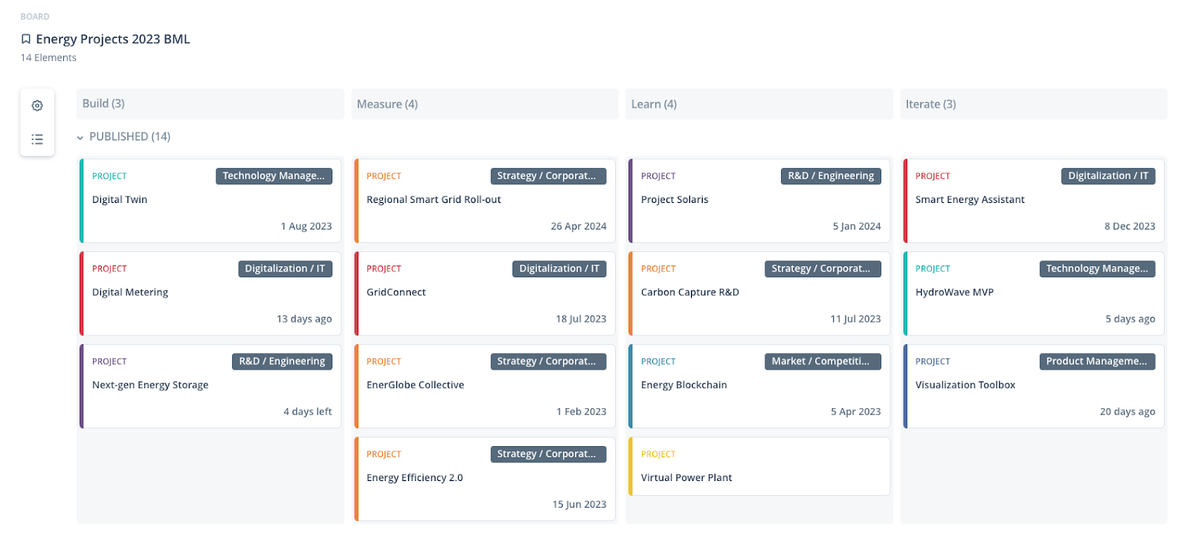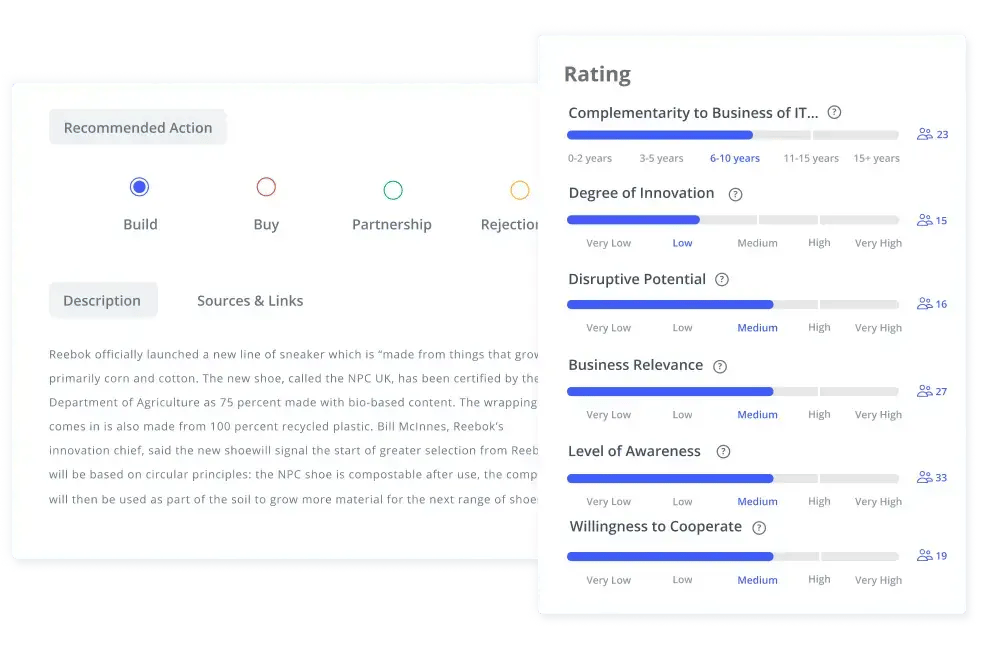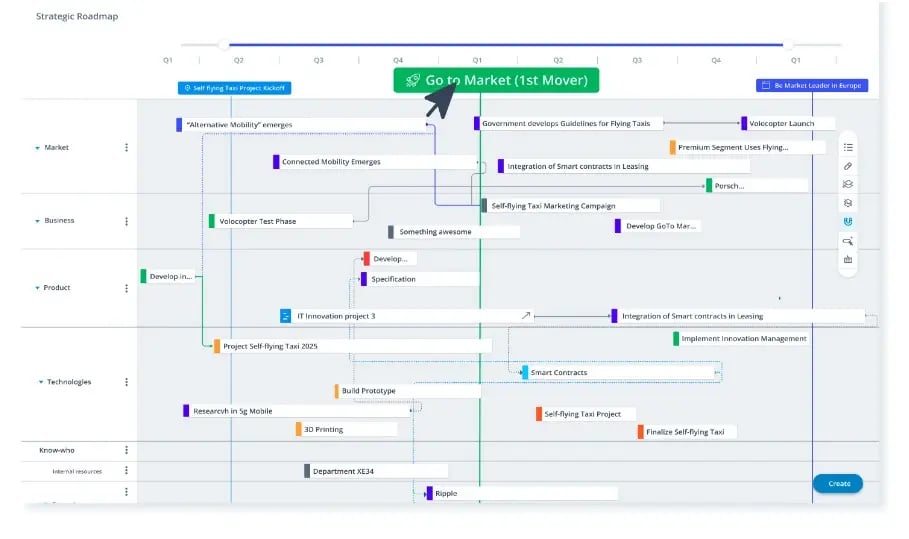According to McKinsey, 84% of executives say innovation is critical to their growth strategy, yet only 6% are satisfied with their innovation performance. This gap highlights the urgent need for effective innovation portfolio management.
A well-managed innovation portfolio serves as a strategic tool to prioritize different projects, align with business goals, and balance risk across short- and long-term initiatives. Providing transparency and structure helps key stakeholders make better decisions, allocate resources efficiently, and track progress toward financial success.
This article explores the essential tools, processes, and tips needed to master innovation portfolio management in today’s dynamic environment.

What is innovation portfolio management
Innovation portfolio management ensures that organizations invest in the right mix of initiatives, aligned with strategy and risk tolerance. It helps identify growth opportunities, allocate enough resources, and manage innovation efforts systematically for long-term impact.
Definition, key principles, and business benefits
Innovation portfolio management is the structured approach to selecting, overseeing, and balancing a company’s portfolio of innovative ideas, projects, and products. It ensures innovation investments are aligned with business strategy and promise long-term returns.
An innovation portfolio includes all active innovation projects (and ideas), from incremental improvements to radical breakthroughs. Managing this portfolio means making deliberate trade-offs between risk, impact, and resource allocation.
A key principle is strategic alignment. Each project must clearly support defined strategic goals. Without alignment, innovation efforts risk becoming disconnected from value creation.
Another principle is diversification. A balanced innovation portfolio spreads risk across short-, mid-, and long-term initiatives as well as initiatives being close, adjacent, or on the edge of the core business. This protects the business from over-reliance on a single innovation path.

The business benefits are significant. With clear visibility into projects and priorities, many organizations achieve better cost savings, faster decision processes, and stronger returns on innovation investments.
Portfolio management also improves accountability. It helps innovation teams justify funding, measure outcomes, and kill underperforming projects early.
Why innovation portfolio management matters more than ever in 2025
In 2025, organizations face increased complexity, cost pressure, and uncertainty. Managing innovation at scale is more difficult as innovation initiatives are chosen more carefully and only when they show clear value potential.
Innovation portfolio management provides exactly this structure that helps to identify low-performing projects and high-value initiatives. It enables senior management to respond quickly, reprioritize, and double down on what works.
As innovation budgets tighten, companies must prove the ROI of their innovation investments. Portfolio management ensures investment goes to the most promising opportunities.
In short, strong innovation portfolio practices drive trust and efficiency by showing a transparent view of the innovation project landscape which is essential for the success of innovation teams in 2025.
The 5 ingredients to manage innovation portfolios successfully
Effective innovation portfolio management requires a structured approach. It balances ambition with execution, enables educated decisions, and ensures the entire innovation process is focused on long-term value creation.
Innovation strategy guiding innovation pipelines
Every strong innovation portfolio starts with a clear innovation strategy. This strategy defines where to play and how to win across markets, technologies, and types of innovation.
%20Innovation%20ambition%20matrix.webp?width=850&height=917&name=6)%20Innovation%20ambition%20matrix.webp)
The innovation strategy should shape the innovation pipeline, from early-stage exploration to scaling solutions. It guides which problems to solve and how to prioritize investment.
Clear direction supports better resource allocation. Without strategic guidance, teams may generate ideas that don’t align with the company’s innovation ambitions.
A robust pipeline includes both incremental improvements and transformational projects. Strategic steering ensures a healthy mix of risk and reward.
The 4 stage innovation portfolio review process: From strategic objectives to lifecycle management
To manage portfolios effectively, innovation managers should use a four-stage review process. Start by translating strategic objectives into evaluation criteria for new projects and existing projects.
Second, assess the current innovation portfolio for balance. Look at project types, timing, risk profiles, and fit with strategic goals.
Third, prioritize and select the best ideas. Ensure each initiative earns its place in the portfolio by delivering clear value and supporting core innovation goals.
Finally, focus on lifecycle management. Review projects regularly, sunset underperformers, and adapt the portfolio based on learnings and environmental shifts.
This ongoing process helps the innovation program to stay agile and make quick decisions under changing conditions.
Clear governance, innovation process, and resource management
Strong governance is essential for effective innovation portfolio management. It ensures transparency, accountability, and alignment across functions and leadership levels.
For instance, use the RACI-matrix to define clear ownership for each step of the innovation journey. This includes roles for idea sourcing, selection, funding, and execution.

Establish a consistent innovation process across the organization. Standardization improves quality, speeds up project management, and reduces wasteful effort.
Effective resource management is also critical. Align skilled teams, time, and budgets with the most promising projects—not just the loudest voices.
When governance and process are aligned, the entire innovation process runs more smoothly and the innovation project is managed at scale.
Innovation success metrics to control healthy portfolio development
What gets measured gets managed. Use the right metrics to track innovation portfolio performance and ensure progress toward long-term goals.
Use both leading and lagging indicators. Leading metrics could include the number of (new) projects per strategic priority or horizon. This relates to measuring the portfolio balance—how your portfolio distributes across different types of innovation (e.g., core, adjacent, disruptive). Other leading innovation metrics could be stage gate progression, or speed to prototype.
Lagging indicators include financial impact, time-to-market, and success rates of transformational projects.

Tracking metrics allows senior management to make educated decisions, optimize the mix of initiatives, and increase confidence in gaining a competitive edge.
Innovation projects vs. ongoing projects: What’s the best portfolio structure?
An optimized innovation portfolio balances innovation projects with ongoing projects. Both play a role, but their purposes and lifecycles differ.
Innovation projects are time-bound and exploratory. They often test new ideas or address emerging customer needs. These projects push boundaries and build future value.
Ongoing projects, by contrast, focus on maintaining or improving existing products and services. They support operational excellence and ideas for continuous improvement.
Segregating the two within your portfolio provides clarity. It also enables tailored governance, metrics, and resourcing.
The best portfolio structure depends on your company’s innovation ambitions and risk appetite. Most organizations benefit from a hybrid approach.
Combining both ensures agility, focus, and sustained growth across the complete innovation process.
Must-have innovation portfolio tools
Successful innovation portfolio management depends on having the right tools. These tools support visibility, collaboration in the innovation community, and control—forming the foundation of a scalable, data-driven portfolio approach.
Modern innovation departments manage dozens of parallel innovation projects. Without the right infrastructure, it's impossible to make informed decisions or track progress toward business goals.
Each of the following tools is a key part of a strong portfolio framework, enabling organizations to manage complexity and unlock innovation potential across innovation teams and regions.
Single innovation pipeline tracking software
A centralized innovation pipeline tool is essential. It gives teams a single source of truth for all innovation activities, from idea intake to implementation.
Tracking software helps innovation departments monitor new ideas, and project health, identify bottlenecks, and visualize the progress of each project.

This visibility enables better forecasting and capacity planning. It also ensures that early-stage ideas don’t get stuck and align with the strategic objectives.
Most importantly, a single pipeline view supports strategic alignment. You can see how every initiative contributes to broader goals and new markets.
This kind of tracking platform is foundational to a structured portfolio approach.
Collaborative project prioritization system
Prioritization is one of the most difficult tasks in innovation portfolio management. A collaborative, criteria-based tool ensures decisions about ideas and innovation projects are transparent, data-driven, and fair.
These systems allow teams to evaluate innovation projects based on strategic fit, risk level, budget requirements, and potential impact.
When multiple stakeholders are involved, the prioritization of ideas and innovation projects becomes more credible. Teams feel heard, and leadership has more confidence in the decisions.

This approach reduces bias and ensures the best innovation initiatives rise to the top—regardless of where the idea originated.
Collaboration in prioritization strengthens alignment across innovation departments and increases ownership at every level.
Innovation ambition matrix
The Innovation Ambition Matrix is a strategic tool that helps organizations balance their innovation portfolio across core, adjacent, and transformational initiatives. By using the Innovation Ambition Matrix, companies can assess whether their current mix of innovation efforts aligns with overall business goals and risk tolerance.
It highlights how much focus is placed on optimizing existing offerings versus exploring new growth opportunities. Applying the Innovation Ambition Matrix ensures that enough resources are allocated to each strategic objective, avoiding overinvestment in low-impact projects or underinvestment in high-potential innovation projects.
Ultimately, the Innovation Ambition Matrix supports more informed, balanced, and future-focused innovation portfolio decisions.
Roadmap that aligns projects with business objectives
An interactive, visual roadmap is a key part of any effective portfolio framework. It shows how innovation initiatives evolve over time and contribute to long-term strategy.
Roadmaps bring clarity to otherwise abstract innovation work. They connect individual projects to specific milestones and business objectives.

This alignment helps manage stakeholder expectations and ensures resources are allocated where they matter most.
Roadmaps also make trade-offs explicit. Leaders can shift focus between short-term wins and long-term new market entries as needed.
Used well, a roadmap becomes a real-time communication tool that unites strategy, execution, and foresight.
Interactive dashboards to control innovation KPIs
Monitoring innovation performance requires real-time data. Interactive dashboards give leaders the visibility needed to steer the portfolio with precision.
Dashboards should track KPIs such as project status, resource utilization, idea-to-launch conversion, and value delivered by innovation initiatives.
With a well-structured dashboard, innovation managers can spot underperforming areas, adjust quickly, and celebrate early wins.
These tools help organizations stay agile. They allow for constant recalibration of innovation efforts without losing sight of strategic intent.
Dashboards are also essential for stakeholder communication. They build trust by making innovation activities measurable, visible, and accountable.

6 best innovation portfolio management tips
Managing an innovation portfolio effectively means more than just tracking projects. Adapting to an evolving environment requires structure, insight, and agility. These six tips help innovation managers overcome common innovation challenges while enabling better results across teams.
Each tip focuses on improving decisions, increasing efficiency, and ensuring innovation remains aligned with strategy, budget, and real-world impact.
Tip 1 – Standardize the decision-making process
Tip 1 – Standardize the decision-making process: From idea generation to launch
Consistency is key. A standardized process supports better evaluation, funding, and execution of innovation projects.
Clear criteria from the moment teams generate ideas help avoid bias and confusion. This consistency drives shared understanding across teams and leadership.
A standardized approach also enables faster approvals and clearer metrics. This reduces innovation risk and improves time-to-market.
From the initial idea to the scaled launch, each step must support sound, informed decision-making.
Tip 2 – Set clear governance
Tip 2 – Set clear governance to manage the project portfolio
Strong governance provides structure and accountability. It defines who can start, stop, or scale specific projects, and ensures they align with company goals.
Governance frameworks clarify ownership, roles, and decision rights—essential for large organizations and innovation managers handling diverse innovation activities.
This structure also helps teams provide feedback, resolve conflicts, and make faster decisions at each stage.
Clear governance reduces friction, mitigates idea risks, and enables teams to allocate resources more effectively.
Tip 3- Integrate market trends into evaluation criteria
Tip 3- Integrate market trends into evaluation criteria
Integrating emerging trends and emerging technologies into project evaluation ensures your portfolio stays future-focused.
Many organizations overlook trends when assessing innovation potential. As a result, they miss signals that could shape their next business model or technology shift.
Evaluation criteria should include market impact, customer feedback, and technology trajectories. This ensures your informed decision making reflects both internal priorities and external realities.
Adapting to emerging trends improves strategic fit and reduces wasted effort on misaligned ideas.
Tip 4 – Map the innovation pipeline visually
Tip 4 – Map the innovation pipeline visually
A visual representation of the innovation pipeline helps everyone see where projects stand and how they move through the system.
Mapping supports shared understanding across business units. It allows for transparent discussions on ideas, project status, resource allocation, and timing.
It also highlights bottlenecks and duplication across stages—critical for improving throughput and reducing innovation challenges.
Visualizing the pipeline supports clarity about achieving strategic objectives that is particularly relevant in fast-moving or decentralized organizations.
Tip 5 – Use AI agents
Tip 5 – Use AI agents to identify bottlenecks and double spending
AI-powered tools can detect inefficiencies humans often miss. For example, AI agents can flag duplicated efforts, resource conflicts, or stalled innovation projects across the portfolio.
This insight helps leaders reduce innovation risk and allocate resources more effectively.
Machine learning algorithms also support project clustering and timeline forecasting, improving the accuracy of informed decision making.
AI tools give innovation teams more time to focus on strategy and less time chasing operational issues.
Tip 6 – Continuously review
Tip 6 – Continuously review and adjust the portfolio
The innovation landscape shifts fast. Continuous review ensures your portfolio stays aligned with strategy, customer needs, and market changes.
Schedule regular portfolio reviews with cross-functional input. Use real-time data to evaluate progress, sunset weak specific projects, and scale what works.
Reviews allow teams to adapt to a changing business environment, reprioritize based on outcomes, and stay focused on the right business model opportunities.
Ongoing evaluation helps reduce sunk-cost bias and strengthens the connection between strategy and execution.
Start with the best innovation portfolio software. Today.
The ITONICS Innovation OS is the modular and best innovation software to give teams the tools they need and foster innovation synergies across the whole organization. Our Innovation OS embodies all the essentials of the best innovation management software and covers all the application areas in one tool. It will help you to:
Eliminate information silos: Dispersed teams and disconnected data often result in missed opportunities and duplicated efforts. With ITONICS, all your new products, most innovative ideas, and market insights are centralized in one place. Create transparency and reduce inefficiencies by keeping everyone on the same page.
Streamline idea and feedback collection: Managing a high volume of ideas from various sources can be overwhelming. ITONICS allows you to capture, evaluate, and prioritize ideas from across the organization, including customers and partners, all in one structured process. This helps focus resources on the most impactful ideas and reduces time wasted on less promising ones.
Track innovation progress across teams: Monitoring the progress of multiple innovation projects across departments isn’t easy. ITONICS provides visual dashboards and roadmapping that give project management a real-time overview of all innovation projects, ensuring you can quickly address roadblocks, identify risks, and keep everything on track.



/Assets%20and%20Heros/nav-thumbnail-Gartner.webp?width=150&name=nav-thumbnail-Gartner.webp)





